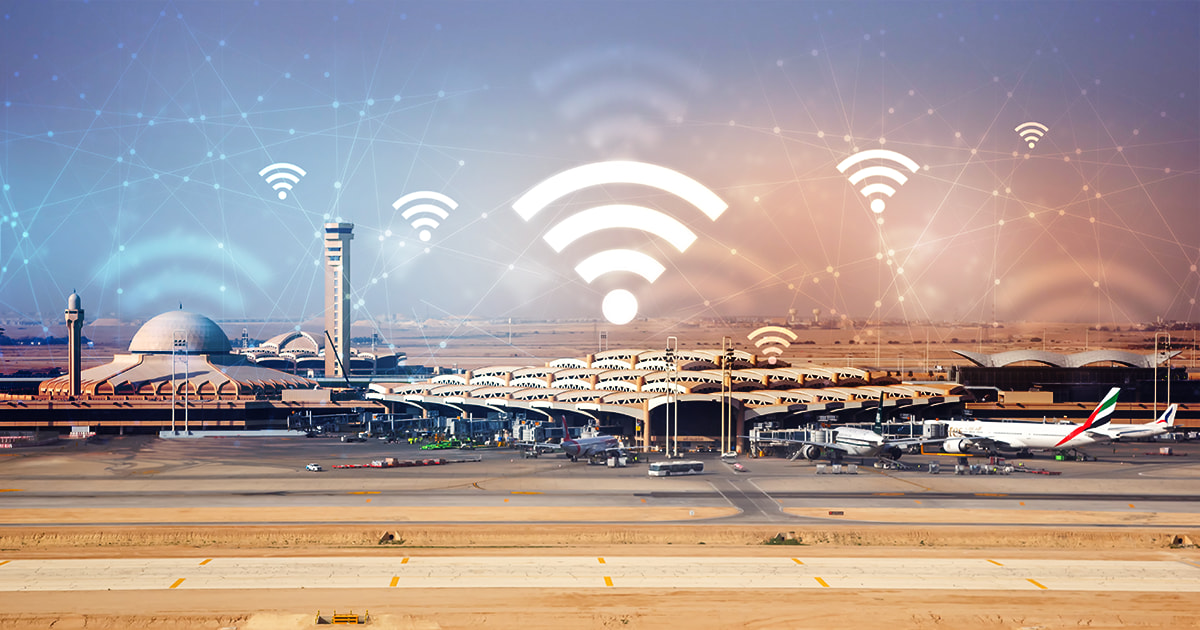Airports in the Gulf region and Türkiye have experienced a surge in air passenger traffic. As they compete to be key transit hubs and main tourist and business destinations, high-performance Wi-Fi networks have become increasingly important in shaping the overall passenger experience. We use Speedtest Intelligence® data to evaluate the Wi-Fi performance of the busiest airports in the region between January and August 2025. These insights help to inform travelers where they are more likely to have the best online experience while transiting through an airport in the region or waiting at a lounge to embark on an outbound flight.
Key Takeaways:
- King Khalid International Airport in Riyadh (RUH) achieves top-tier public Wi-Fi download speeds of over 86 Mbps. Wi-Fi performance in airports across the Gulf region and Türkiye varies significantly, with RUH offering strong public Wi-Fi speeds ahead of Hamad International Airport in Doha (DOH) and Dubai International Airport (DXB). Kuwait International Airport (KWI) and Zayed International Airport in Abu Dhabi (AUH) fall in the mid-range of download speeds, and the two airports in Istanbul, IST and Sabiha Gokcen (SAW), lag considerably.
- Very few airport lounges provide superior Wi-Fi performance compared to the general public airport networks. The fastest lounges, such as those in IST and DXB, exhibit a substantial increase in download speeds, 5X for the former and 2X for the latter, compared to public airport Wi-Fi. Top lounges in other airports, such as at RUH and Zayed International Airport in Abu Dhabi (AUH), offer more modest speed gains. Without the ability to demonstrate superior Wi-Fi performance, lounge operators are missing out on a point of differentiation to add to comfort and other amenities.
- Wi-Fi performance differs greatly between lounges, even within the same airport. This suggests that the specific lounge operator plays a crucial role in determining the quality of the Wi-Fi experience. For instance, in Riyadh (RUH), the Al Fursan lounge significantly outperforms the Plaza Premium and HAYYAK lounges. Similarly, in Dubai (DXB), the Marhaba lounge boasts much faster speeds than the Emirates (EK) lounge or the DIH lounge. Lounge operators must address these performance gaps to remain competitive, attract high-value customers, and enhance guest experience and satisfaction.
Wi-Fi performance varies significantly across Middle East and Türkiye airports
Airline passengers today expect seamless connectivity, from check-in to landing. That is why airport operators need to understand how passengers (and staff) access the internet throughout the venue, and ensure their infrastructure meets their connectivity needs.
In January 2025, Ookla® analyzed the cellular performance at the busiest airport in the Gulf region and Türkiye. We found that Abu Dhabi’s Zayed International Airport (AUH) achieved top-tier median mobile download speeds of over 450 Mbps. In comparison, Istanbul Airport (IST) significantly leads in 5G performance, with download and upload speeds of 861.98 Mbps and 101.96 Mbps, respectively.
This time, we used Speedtest Intelligence data to understand whether the public Wi-Fi networks and lounges of the nine busiest airports in the Middle East and Türkiye deliver the kind of internet experience travelers expect—whether that’s for streaming, video calls, or quick file uploads. We compared median Wi-Fi download and upload speeds at each location over a period of eight months (January to August 2025).
Ookla’s data shows that Wi-Fi performance varies greatly from airport to airport. King Khalid International Airport in Riyadh (RUH) has the highest download speed at 86.34 Mbps, placing it at the top of the list, while its upload speed is a more moderate 25.48 Mbps. In contrast, Hamad International Airport in Doha (DOH) and Dubai International Airport (DXB) demonstrate high upload speeds; Dubai leads with 101.86 Mbps, and Doha follows closely at 96.45 Mbps. DXB and DOH also stand out because they are the only two airports where upload speed is higher than download speed.
The two airports in Istanbul, IST and Sabiha Gokcen (SAW), generally have the lowest speeds. IST has a download speed of 22.65 Mbps and an upload speed of 22.20 Mbps, while SAW ranks at the bottom for both metrics, with a download speed of 9.69 Mbps and an upload speed of 9.52 Mbps.
Other airports, like Kuwait International Airport (KWI) and Zayed International Airport in Abu Dhabi (AUH), fall in the mid-range for download and upload speeds. At the same time, Sharjah International Airport (SHJ) and Muscat International Airport (MCT) show slower, sub-30 Mbps download speeds.
Wi-Fi Network Performance, Select Airports in the Gulf Region and Türkiye
Speedtest Intelligence® | January–August 2025
Wi-Fi Network Performance, Select Airports in the Gulf Region and Türkiye
A few airport lounges offer better Wi-Fi performance than public airport networks, but the majority need improvements
Good Wi-Fi in airport lounges is essential for enhancing the travel experience, especially as their popularity grows. With more travelers seeking comfort and productivity during layovers, the demand for reliable internet access has never been higher.
Airport and airline companies position lounges as distinctive features to cater to the needs of business travelers, families, and leisure travelers. A survey by Airport Dimensions revealed that lounge users enjoy the airport more than non-users. Lounge visits are common among frequent travelers in the Middle East, with 66% of those in the U.A.E. and 60% in Saudi Arabia utilizing lounges during their trips. This trend is driven by various factors, including the desire for a more comfortable environment and the availability of amenities, but also the increasing number of financial institutions that incorporate premium travel-related benefits such as lounge access into their loyalty strategies.
Lounges typically offer dedicated and faster Wi-Fi than the general airport network, making them an attractive option for business travelers and those looking to maximize productivity. Hamad International Airport in Doha is the exception where a single public Wi-Fi network is deployed and accessible to everyone, including inside the lounges.
We used Speedtest Intelligence data again to examine the download speed that is typically experienced at different airport lounges, and we selected the venues with the highest number of samples, indicating more popularity. Note that we have excluded Kuwait International Airport (KWI) or Sharjah International Airport (SHJ), as there were no Speedtest samples captured that were associated with lounges in these two locations. We have also aggregated samples from different lounges within the same airport that share the same Wi-Fi Service Set Identifier (SSID).
Ookla data suggests that the fastest lounge’s Wi-Fi performance in all airports is superior to that of the general public Wi-Fi network. The most dramatic difference is at Istanbul Airport (IST), where the YOTEL lounge Wi-Fi clocks in at 119.46 Mbps, while the public Wi-Fi lags far behind at 22.65 Mbps. Similarly, airports in Riyadh (RUH) and Dubai (DXB) show substantial advantages for Saudia’ Al Fursan and Marhaba lounge users over the free public Wi-Fi, with lounge speeds reaching 120.5 Mbps and 101.98 Mbps, respectively.
The Pearl Lounge in Abu Dhabi Airport (AUH) shows the smallest speed increase over the free Wi-Fi network. At the other end of the spectrum, Istanbul’s Sabiha Gökçen Airport (SAW) recorded the slowest speeds for lounge Wi-Fi at 25.8 Mbps, lagging the other airports in public Wi-Fi ranking.
Performance Comparison Between the Fastest Lounge Wi-Fi and Public Airport Wi-Fi, Select Airports in the Gulf Region and Türkiye
Speedtest Intelligence® | January–August 2025
Performance Comparison Between the Fastest Lounge Wi-Fi and Public Airport Wi-Fi, Select Airports in the Gulf Region and Türkiye
Wi-Fi performance across lounges in the same airport exhibits strong variation, emphasizing that the choice of a lounge could be a critical factor for travelers needing a fast internet connection. In Riyadh’s RUH, the Al Fursan lounge delivers a fast median download speed of 120.5 Mbps, contrasting strongly with Plaza Premium and HAYYAK lounges in the same airport, which offer sub-22 Mbps speeds. A similar, though less extreme disparity can be observed in Istanbul Airport (IST), where YOTEL lounges provide a download speed that is more than double that of the iGA lounge at 48.32 Mbps.
Dubai International Airport (DXB) is another example of substantial intra-airport variability. While Marhaba lounge boasts a speed of nearly 101.98 Mbps, airline Emirates’s (EK) lounges provided slower download speeds of just over 60 Mbps. The Dubai International Hotel (DIH) lounge offers a mere 29.16 Mbps download speed at the same location.
Airports like Abu Dhabi (AUH) and Muscat (MCT) exhibit more consistent, albeit moderate, speeds across their lounge offerings in the 40-55 Mbps range; still, it is faster than the public airport Wi-Fi. The Plaza Premium Lounge in Istanbul (SAW) offers slightly better Wi-Fi than the public Wi-Fi but still lags behind the other lounges, except its sister lounge in Abu Dhabi.
The surge in air passenger traffic and growing demand for seamless connectivity underscore a critical need for airport operators and lounge managers to prioritize and invest in their Wi-Fi infrastructure to enhance their overall experience and gain a competitive edge. Our analysis of the busiest airports in the Gulf region and Türkiye shows that while some locations offer high-performance Wi-Fi networks, the variability in speeds across different venues and even within the same airport’s lounges highlights significant opportunities for improvement.
Airport authorities and lounge operators must actively monitor and enhance their Wi-Fi capabilities to meet and exceed traveler expectations and differentiate their offerings in a competitive market. By doing so, they can unlock new growth opportunities, improve customer loyalty, and strengthen their position as major global travel hubs.
Please contact us for more details on how tools such as Speedtest Intelligence can help provide actionable insights into network performance and become Speedtest Certified™ to publicly demonstrate your commitment to delivering top-tier internet experiences for every traveler.





![What Google Material 3 Expressive redesigns are rolling out [U]](https://afnnews.qaasid.com/wp-content/uploads/2025/10/1760298787_Material-3-Expressive-Google-apps.jpg)






